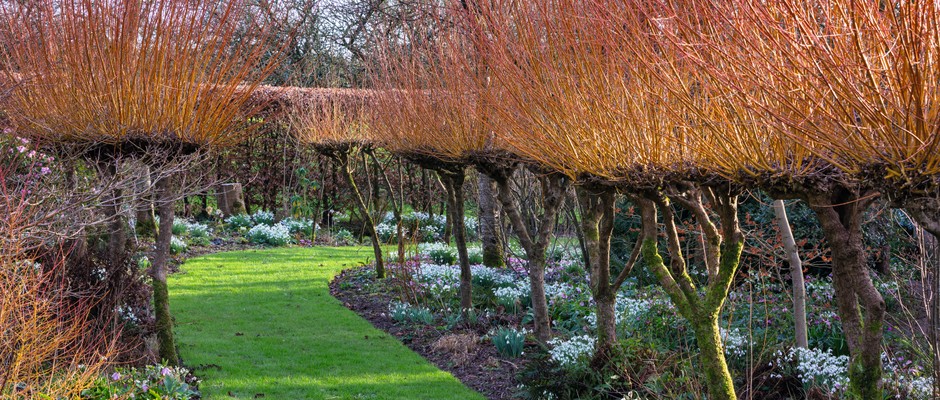
A Devon garden filled with winter colour
Jo Hynes has filled her Devon garden with snowdrops, cyclamen and other early flowers. Words Ambra Edwards. Photography Richard Bloom.
Two rows of willows flank the path from the house to the orchard in Jo Hynes’ Devon garden, the new orange growth resembling a line of blazing torches. “I used to do a lot of basket weaving,” explains Jo. “This was a very wet bit of garden, ideal for growing willows. The main planting is of Salix alba var. vitellina ‘Britzensis’, which keeps its fiery colour when you weave it.”
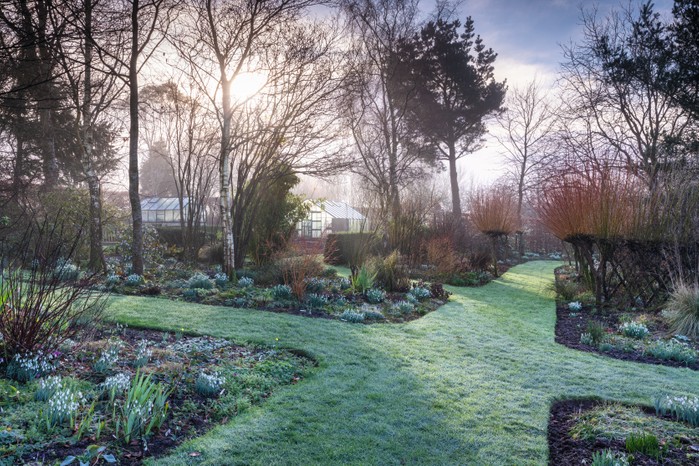
Higher Cherubeer is an eminently practical garden. Standing at an elevation of 150m at the head of a west-facing valley on the edge of Dartmoor, it is prey to ferocious winds. So the Hynes’ first task on arrival was to plant a protective beech hedge and shelter belts of native trees that would blend harmoniously with the surrounding fields. The garden has evolved with the family. Paths have formed along desire lines, marking out the quickest route to the orchard, chicken run, or veg patch, or a favourite spot to pause and look out at the view. Jo’s husband Tom has terraced the sloping land into two flat lawns, patiently collecting field stone and building it into dry-stone walls.
IN BRIEF
What Naturalistic woodland garden, home to collections of cyclamen and snowdrops and other winter plants.
Where Devon.
Soil Stony acid clay.
Size One and a quarter acres.
Climate Windy and rainy.
Hardiness zone USDA 8.
Gardening in the rain has been transformed by the creation of a ‘gravel superhighway’. “We can now get right round the garden without going on the grass – and better still, get a barrow all the way,” enthuses Jo. Winter visitors like it too – they can admire her extensive collection of snowdrops without getting their feet wet. A broad grass path cuts a firm diagonal through the garden, anchoring the meandering paths and irregular planting spaces, crammed at this season with a plethora of early flowering plants.
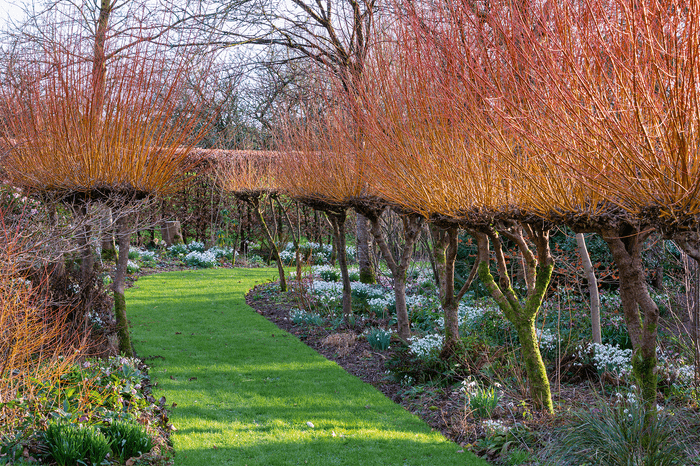
A winding grass path at Higher Cherubeer is flanked by a colonnade of Salix alba var. vitellina ‘Britzensis’ ornamented with hellebores, snowdrops and other early bulbs.

Surrounding the greenhouses, which shelter collections of rare snowdrops, cyclamen and hepaticas, are generous areas of planting designed to support bees. Nectar-rich trees are underplanted with early flowering shrubs and flowers that provide an invaluable food source at a lean time of year.
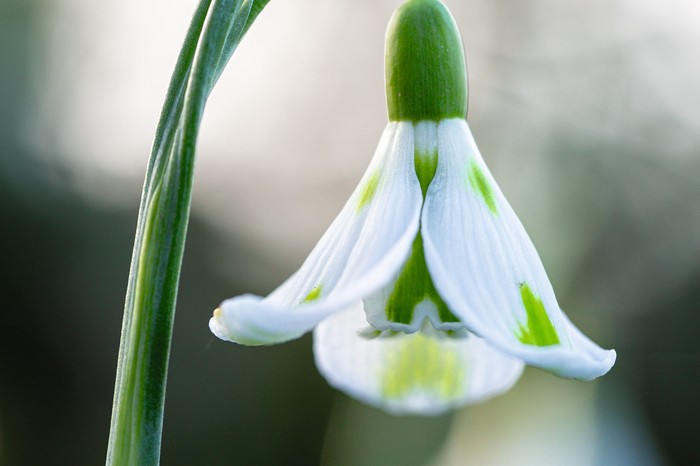
Jo grows some 400 different snowdrops, but is especially fond of the Greek species Galanthus ikariae. “It self-seeds round the garden so it always looks very natural,” says Jo – an effect harder to achieve with sterile hybrids, which must be lifted and divided every few years. As well as collecting, Jo has bred several new cultivars of her own, two of which, ‘Jack Hynes’ and ‘Daisy Hynes’, she named after her children.
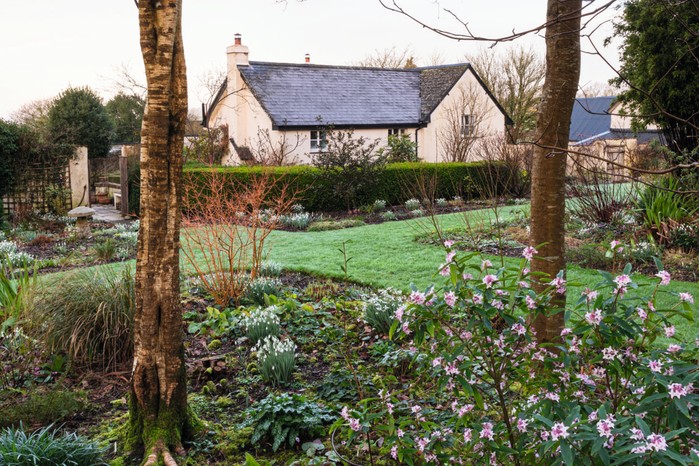
In a shady bed near the house snowdrops, cyclamen and other early flowerers join winter shrubs, including the fiery orange Cornus sanguinea ‘Midwinter Fire’ and the sweetly scented Daphne bholua. Its powerful fragrance is one of the great joys of the early spring garden.
Mature trees shelter many thousands of woodland perennials, most offering not only delicate blooms but also handsome foliage – masses of glossy-leaved hellebores, spotted and splashed pulmonarias, marbled Arum italicum and the striking giant golden saxifrage, Chrysosplenium macrophyllum, with waxy inflorescences set off by large, bergenia-like leaves. There are erythroniums just starting into flower, and various kinds of epimedium.
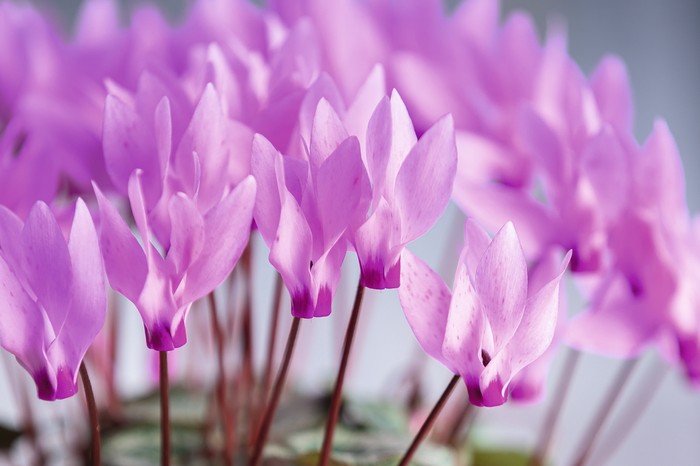
But for sheer beauty and variety of foliage, there is nothing to match the swathes of cyclamen clustered around the roots of the trees – their dainty leaves silver and malachite, speckled and striped, in endless variation of pattern.
Jo’s interest in cyclamen began in a garden in the south Devon village of Kellaton, where Cyclamen hederifolium had once been grown as a cut flower, and had run wild: here she collected seed and experimented with growing plants from scratch. Before long, she was travelling to see cyclamen growing in the wild: some 23 species are distributed around the Mediterranean and the Near East. “We’ve been to Turkey, to Jordan, all down the Adriatic coast, everywhere from the Crimea to the Golan Heights. We’ve seen them growing out of rocks and cliff faces, and in alpine meadows, as well as carpeting the forest floor like sheets of bluebells.”
Jo now holds a National Collection, growing some 22 species in around 80 taxa. Among the trees, Jo grows familiar species such as winter-flowering Cyclamen coum, autumn-flowering Cyclamen hederifolium and the highly scented, evergreen Cyclamen purpurascens from Lake Garda in northern Italy, where it is used in the perfume industry.
Here's our plant profile on how to grow cyclamen
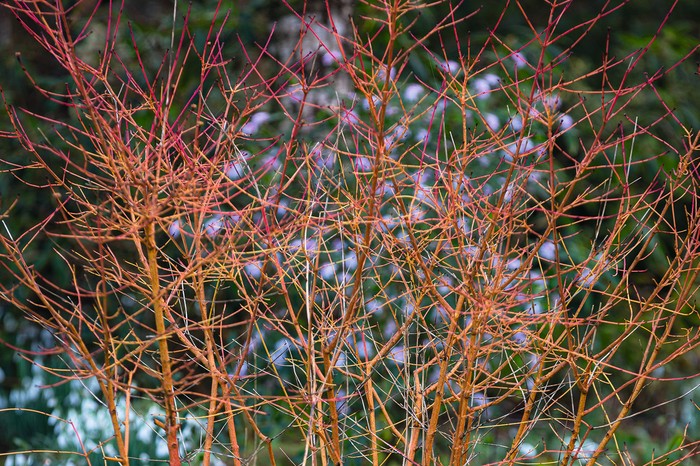
Shrubs with colourful winter stems, such as willow and dogwood, are also in abundance. These are coppiced annually in spring for the best winter colour.
Useful information
The garden opens for the National Garden Scheme.
Authors
Ambra Edwards is a garden writer with a special interest in garden history, and above all, in the people who make gardens.

Niwaki bundle worth £57 when you subscribe
Subscribe to Gardens Illustrated magazine and claim your Niwaki bundle worth £57
*UK only

Container Gardening Special Edition
The Gardens Illustrated Guide to Container Gardening.
In this special edition, discover colourful flower combinations and seasonal planting schemes for pots designed by leading plantspeople, and essential know-how for container gardening success. Just £9.99 inc UK p&pBy entering your details, you are agreeing to our terms and conditions and privacy policy. You can unsubscribe at any time.
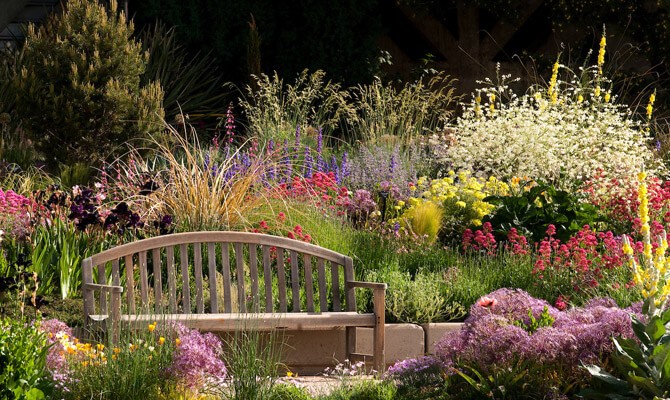
Gardens of the Globe
From botanical wonders in Australia to tranquil havens closer to home in Ireland, let this guide help you to discover some of the most glorious gardens around the world
By entering your details, you are agreeing to our terms and conditions and privacy policy. You can unsubscribe at any time.




